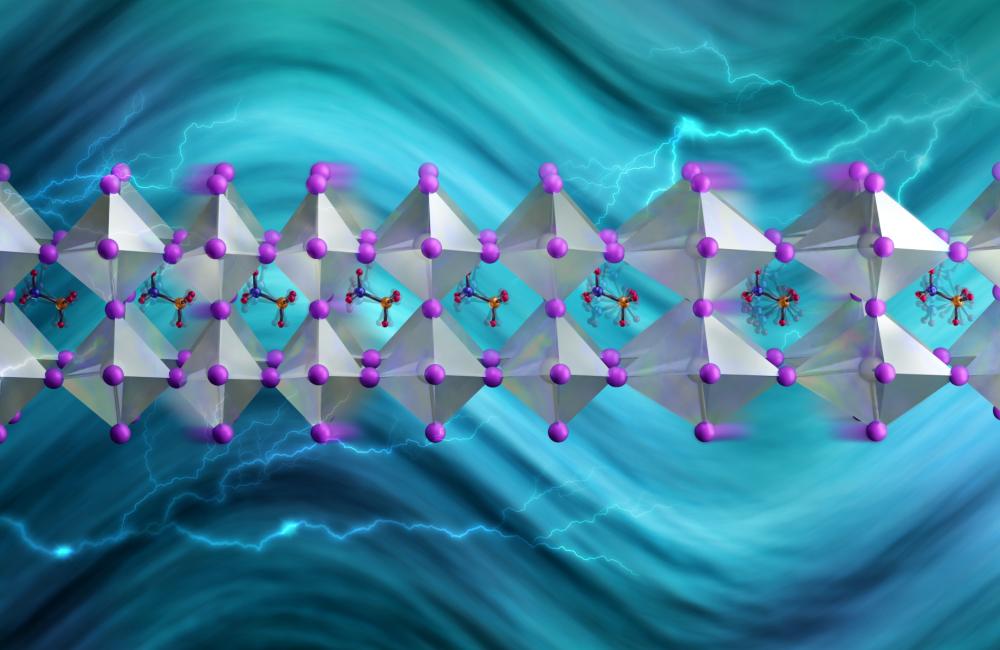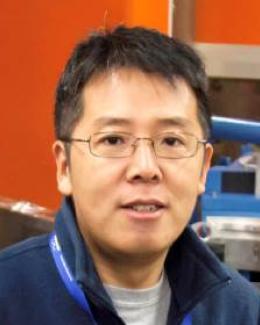Substituting deuterium for hydrogen makes methylammonium heavier and slows its swaying so it can interact with vibrations that remove heat, keeping charge carriers hot longer. Credit: Jill Hemman/ORNL, U.S. Dept. of Energy
Led by the Department of Energy’s Oak Ridge National Laboratory and the University of Tennessee, Knoxville, a study of a solar-energy material with a bright future revealed a way to slow phonons, the waves that transport heat. The discovery could improve novel hot-carrier solar cells, which convert sunlight to electricity more efficiently than conventional solar cells by harnessing photogenerated charge carriers before they lose energy to heat.
“We showed that the thermal transport and charge-carrier cooling time can be manipulated by changing the mass of hydrogen atoms in a photovoltaic material,” said ORNL’s Michael Manley. “This route for extending the lifetime of charge carriers bares new strategies for achieving record solar-to-electric conversion efficiency in novel hot-carrier solar cells.”
UT’s Mahshid Ahmadi noted, “Tuning the organic-molecule dynamics can enable control of phonons important to thermal conductivity in organometallic perovskites.” These semiconducting materials are promising for photovoltaic applications.
Manley and Ahmadi designed and managed the study, published in Science Advances. Experts in materials synthesis, neutron scattering, laser spectroscopy and condensed matter theory discovered a way to inhibit wasteful charge cooling by swapping a lighter isotope for a heavier one in an organometallic perovskite.
When sunlight strikes a solar cell, photons create charge carriers — electrons and holes — in an absorber material. Hot-carrier solar cells quickly convert the energy of the charge carriers to electricity before it is lost as waste heat. Preventing heat loss is a grand challenge for these solar cells, which have the potential to be twice as efficient as conventional solar cells.
The conversion efficiency of conventional perovskite solar cells has improved from 3% in 2009 to more than 25% in 2020. A well-designed hot-carrier device could achieve a theoretical conversion efficiency approaching 66%.
The researchers studied methylammonium lead iodide, a perovskite absorber material. In its lattice, collective excitations of atoms create vibrations. Vibrations moving in sync with each other are acoustic phonons, whereas those moving out of sync are optical phonons.
“Typically, charge carriers first lose their heat to optical phonons, which propagate slower than acoustic phonons,” explained ORNL co-author Raphael Hermann. “Later, optical phonons interact with acoustic phonons that carry away this energy.”
However, in a region called the “hot phonon bottleneck,” exotic physics prevent electrons from losing their energy to collective vibrations that transport heat. To enhance this effect in a photovoltaic perovskite, the researchers used inertia, the tendency of an object to keep doing what it’s doing, be that resting or moving.
“We basically slowed down how fast the molecules can sway, similar to slowing a spinning ice skater by putting weights in her hands,” Hermann said.
To do that in an orderly atomic lattice, Ahmadi and ORNL’s Kunlun Hong led the synthesis of crystals of methylammonium lead iodide at the Center for Nanophase Materials Sciences, a DOE Office of Science User Facility at ORNL. They substituted a lighter isotope of hydrogen, normally occurring protium, which has no neutrons, with a heavier one, deuterium, which has one neutron, in the perovskite’s central organic molecule, methylammonium, or MA. Isotopes are chemically identical atoms that differ only in mass owing to the difference in neutron number.
Next, Manley and Hermann together with ORNL’s Songxue Chi conducted triple-axis neutron scattering experiments at the High Flux Isotope Reactor, a DOE Office of Science User Facility at ORNL, to map the phonon dispersion in protonated and deuterated crystals. Because they saw a disagreement between their measurements and published data from inelastic X-ray measurements, they made additional measurements at the Spallation Neutron Source, another DOE Office of Science User Facility at ORNL. There, Luke Daemen of ORNL used the VISION vibrational spectrometer to reveal all possible vibrational energies. The combined results indicated that longitudinal acoustic modes with short wavelengths propagate more slowly in the deuterated sample, suggesting thermal conductivity may be reduced.
Hsin Wang of ORNL performed thermal diffusivity measurements to investigate how heat moved in the crystals. “Those measurements told us that deuteration decreased the already-low thermal conductivity by 50%,” Manley said. “We realized then that maybe this finding affects things that builders of solar devices care about — specifically, keeping charge carriers hot.”
The study provided unprecedented understanding of the effect of atomic mass increase on heat transfer.
“A lot of vibrations, like stretching modes for the hydrogen atoms, have such high frequencies that they don't normally interact with the lower-energy vibrations of the crystal,” Daemen said. The lower-energy modes include swaying of molecules.
The swaying frequency of the organic molecule MA is a little higher than the frequency of the collective vibrations. However, when a deuterium atom substitutes for a lighter hydrogen isotope, its greater mass slows the swaying of MA. It sways at a frequency closer to that of the collective vibrations, and the two start to interact and then strongly couple. The synced phonons slow, becoming less effective at removing heat.
Hermann compared the influence of frequency to a boy’s different actions when his father pushes him on a swing. “The protonated case is like the boy moving his legs too fast to be in sync with the dad pushing. He’s not going to go higher. But if he starts moving his legs at about the same frequency as the swinging, that’s like the deuterated case. The kid has slowed down his legs just enough so that he’s starting to get in sync with the pushed swing, adding momentum. He is able to swing higher because the two motions are coupled.”
The ORNL measurements revealed an effect that far exceeded what was expected from changing the mass of the hydrogen: Deuteration slowed heat transport so much that the charge-carrier cooling time doubled.
To confirm this finding, ORNL co-author Chengyun Hua used pump–probe laser experiments to measure the electrons’ energy dissipation in the deuterated and protonated perovskites over tiny timescales, quadrillionths of a second.
“These measurements confirmed that the giant changes in phonons and thermal conductivity that the heavy isotope induced translate into a slower relaxation time for photo-excited electrons,” Hua said. “This is an important factor in improving photovoltaic properties.”
University of California, Berkeley, co-authors Yao Cai and Mark Asta, who is also with DOE’s Lawrence Berkeley National Laboratory, performed theory-based calculations to provide insight into complexities of phonon behavior.
The discovery made in the ORNL–UT-led study may provide a bright spot for future manufacturers of hot-carrier solar cells.
“Phonons look like a pretty effective knob to turn, and we know how to turn the knob,” Manley said. “When you want to improve the materials, you can add a molecule, methylammonium or something else. The finding can inform developers’ decisions about how they grow their crystals.”
Added Ahmadi, “This knowledge can be used to guide materials design for applications beyond photovoltaics, such as optical sensors and communication devices.”
The title of the paper is “Giant isotope effect on phonon dispersion and thermal conductivity in methylammonium lead iodide.”
The DOE Office of Science, DOE Office of Energy Efficiency and Renewable Energy's Vehicle Technology Office and U.S. Department of Homeland Security supported the research.
UT-Battelle manages ORNL for DOE’s Office of Science. The single largest supporter of basic research in the physical sciences in the United States, the Office of Science is working to address some of the most pressing challenges of our time. For more information, please visit https://www.energy.gov/science/.








